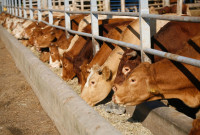Beef demand in Greece remains consistently strong, averaging 158,000 tons annually between 2021 and 2023. Despite this steady demand, Greece faces a significant challenge with its low beef self-sufficiency rate, recorded at just 19.1% in 2023. Most of Greece's beef supply is imported, primarily from Central and Western European countries, positioning Greece—alongside Malta—among the lowest in Europe in terms of self-sufficiency in beef production.
However, despite this dependence on imports, the Greek beef industry holds considerable potential for growth.
Domestic Beef Production vs Imports
In 2023, Greece's domestic beef production reached approximately 30,000 tons, sourced from the slaughter of 119,435 Greek cattle. This includes various categories such as Veal, Young Veal, Young Beef, and Beef. In contrast, beef imports, both fresh and frozen, amounted to a staggering 123,500 tons. This figure also includes portions of animals slaughtered in Greece but born abroad.
The Need for Market Growth
The low self-sufficiency rate is a clear indication of Greece's heavy reliance on imported beef. Chart 1 below highlights the historical trend of Greece’s beef self-sufficiency index, demonstrating that improving self-sufficiency is a complex, multi-faceted challenge that requires coordinated efforts across the beef value chain.
Chart 1: Greece’s Beef Self-Sufficiency Index

Source: Data processed from Eurostat & ELGO Dimitra databases (I. Kaimakamis, 2024)
Key takeaway: The data underscores one crucial fact: "There is a market!"—one that remains largely untapped by domestic producers.
Current Beef Production Systems in Greece
Greece employs four primary cattle breeding and fattening systems, each with its own challenges and inefficiencies:
- Cow-calf production (raising calves from birth)
- Fattening beef breeds raised locally
- Fattening calves imported at 6–10 months of age
- Fattening calves from dairy herds (primarily Holstein, occasionally crossbred with beef or dairy breeds)
Unfortunately, all these systems have been evaluated as inefficient or generating low-profit margins. To capitalize on the market potential, a comprehensive restructuring of the beef supply chain is needed. This transformation requires investments, policy reform, and fostering a new culture within the industry.
A Call for Action: Developing Greece's Beef Industry
Greece's beef supply chain needs an overhaul to meet production and market demands in terms of quality and quantity. This includes addressing the seasonality of beef production and ensuring livestock is available on a planned and regular basis. Currently, little has been done to achieve this consistency.
Mitigating Risks and Improving Cash Flow
At our family-owned cattle breeding and fattening unit, we’ve adopted a diversified strategy to hedge risks and improve cash flow. Over the past two years, we have implemented a dual approach:
- Conventional cow-calf system: We produce calves born and raised in Greece.
- Fattening purchased calves: We purchase calves weighing between 200 and 450 kg, either from the domestic market (Greece) or imported from Western Europe (mainly France).
We anticipate the effectiveness of this strategy will become clear at the end of the current financial year. At that point, we will have concrete data and figures for further analysis and evaluation.
Conclusion: A Path to Growth for Greece’s Beef Industry
Greece’s low self-sufficiency in beef production presents both a challenge and an opportunity. With domestic demand remaining high, there is a pressing need for transformation within the beef fattening and breeding industry. By addressing inefficiencies and fostering collaboration across stakeholders, Greece can seize the opportunity to grow its domestic production, reduce reliance on imports, and build a sustainable, profitable beef market.
Further reading
3-NOP Feed Additive: Mitigating Climate Change by Reducing Cattle Methane Emissions
How the French Livestock Model Can Inspire Greek Farming
How to reduce heat stress in dairy cattle
AgTech Advancements in Beef and Dairy Cattle Production
Sustainable Livestock Production Practices and Animal Welfare




